1521-2021 (Part 3): The Kapuluan (Archipelago) with Many Ancient Secrets
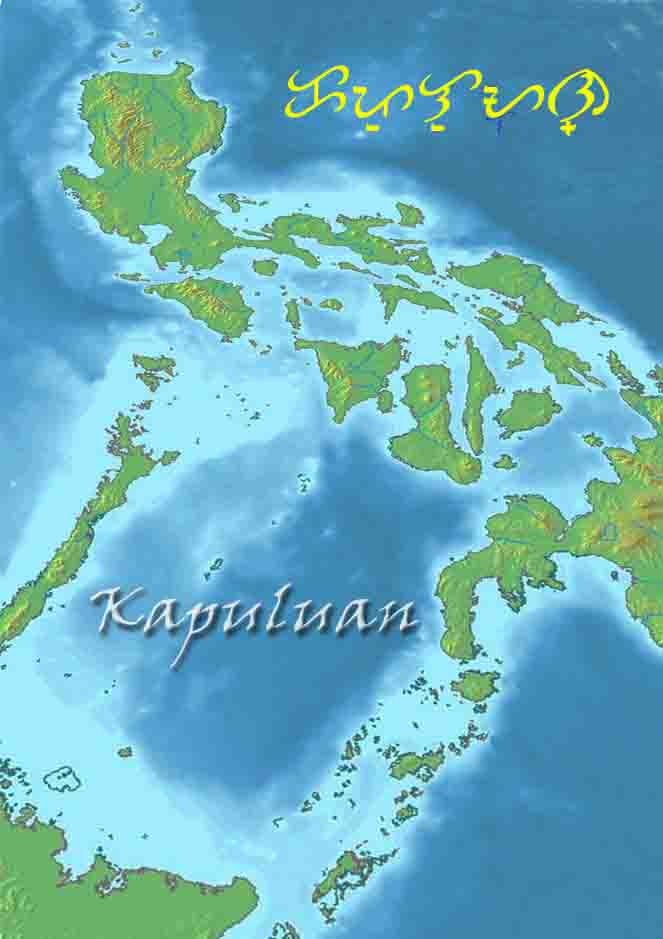
Have you ever wondered how this archipelago which Columbus and Magellan had both set out to “discover” has been historically and traditionally called Kapuluan (a chain or group of islands, archipelago), purportedly from the root word pulô (Tagalog word for island or islet)? But do we know where pulô or other words similar to it come from? The answers trace a quite interesting narrative that could explain a lot of mysteries about the people who had lived on these islands for millennia long before those two European explorers plowed the oceans in search of gold and rich lands to possess.
To be sure, this article is but one possible story or view among many floating around; but it is solidly founded on facts derived from biblical history, secular history, linguistics and the traditional beliefs of the natives who have dwelt on these islands. Believe or not.
The word pulô, when pronounced with the stress not on the second but the first syllable (puló), means ten (10) in many dialects, such as Cebuano, Ilocano and Bicolano. So, how do we relate a single islet (pulô) with the number 10 (puló) without stretching it, if they are at all related? How can 10 fingers, 10 toes or 10 seashells, for one thing, be connected to over 7,000 islands that compose this archipelago? Looks suspiciously like forcing the connection, no? Not really!
The story is told of Noah dividing the world and distributing it among his 3 children, Ham, Shem and Japheth after the Flood. The time he did that was, interestingly, when he already had many grandchildren. (Gen. 10) Which makes sense! For when Joshua divided Canaan among the children of Israel, the 12 tribes had grown into millions of men, women, children and grandchildren from the estimated 600,000 fighting men plus many more who left Egypt. In fact, one person is our link and vital key to that time when Noah did the dividing: Peleg, the great-great-grandson of Noah by Shem and his son, Joktan.
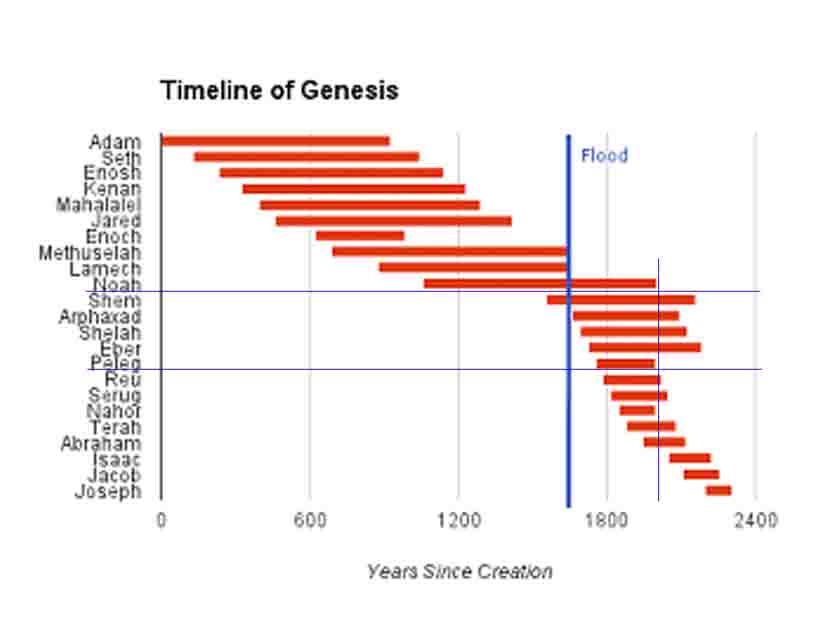
Source: https://coatofmanycolors.net/2013/08/26/timeline-of-genesis-from-adam-to-joseph/
Take particular note of the timeline and genealogy from Noah to Peleg; Noah lived much longer than his sons and grandchildren. The lines provided even seem to show that he outlived Peleg and also lived through the prime years of Peleg’s elders, including Shem. He was literally the last of the almost-millennarians, the 10th from Adam.
Peleg means divided. He got his name from Noah’s actual division of the globe as inheritance to his descendants. (Gen. 10:25) In ancient Aramaic, Peleg also means brook, which carries the idea of dividing a land into two sides of the waterway. So, Peleg’s part of the inheritance given to his parents, Joktan and wife, when he was born, may have been along the boundary of a brook. What brook or stream or river might that be?
From a close reading of the Book of Jubilees, we can see that the writer was referring to one of the four heads of the River Pishon which flowed through Eden. It was the ancient river that flowed by the land where Noah’s children settled after the flood. It is neither in Mesopotamia nor in the Middle East but in the Far East, where the islands at the ends of the Earth were found. (A video reference will explain the whole story of the world’s division by Noah here in this link.)
The name Peleg has a variant spelling of Pulog and, in fact, Peleg itself can be pronounced like Pulog or Pulag by the mountain tribes of Cordillera in Luzon (e sounding almost like a guttural uh). (Note: Hebrew words are written without vowels, much like Baybayin, as we have seen.) And the highest mountain peak in the island of Luzon is called Mt. Pulog or Mt. Pulag by the residents of Kabayan, Benguet in the Cordillera Mountain Range where the peak rises over the largest island right at the middle of the widest portion of Luzon. The name, as well as the mountain, is a monumental landmark of that historic event in the life of the New Father of All Nations, and the Inheritor of the Newly-Cleansed Earth, Noah, when he bequeathed God’s renewed and rested Creation to his direct descendants.
The act of dividing the world was a momentous event which is almost as significant as the Great Flood itself. For what did the Flood really accomplish, other than to destroy? To prepare the Earth for the fresh and rested humans that God had given to Noah to replenish the world with, that is, his descendants (Noah’s name means “REST”). In God’s terms: TAKE TEN! It took 10 generations for God to rest and refresh the Earth the first time. Isaiah would talk about another rest and refreshing and which Paul would explain to us, farther prophesying a final rest and refreshing from our own human labors. (Isa. 28:11-22, Heb. 4:1-8)
But there is more! The name Peleg or Pulog or Pulag bore a prophetic meaning. For aside from significantly referring to the dividing of the entire Earth, it also referred to the island or a literal separated land or group of islands (archipelago) which Joktan received and where his descendants dwelt for centuries up to the present. (See this link.) Notice also that archipelago is made up of two words archi and pelago, meaning main sea or place where there are islands (perhaps, the Pacific Ocean?). Pelagos (sea) and Peleg (brook) are quite similar in connotation; for a body of water necessarily “divides” (from the organic meaning of Peleg) two bodies of land as well. The Mediterranean separated Europe from Africa, while Pishon, the great ancient river, originally divided the one continent we call Pangaea and later on became a mere trench when the Pacific Ocean was formed during the Flood. (For a more detailed explanation of how this occurred, read the book “How the Earth Expanded During the Great Flood: Noah’s Ark and the Earth Rebuilt” – New Edition.)
Notice then that Peleg or Pulog also sounds quite similar to pulô, for island or islet. And Luzon is definitely an island among so many other divided islands that lie along the great ancient River Pishon now submerged as the great trench running along the eastern flank of the archipelago. Those coastal areas could very well be what the Bible refers to as the literal “ends of the earth”, meaning the farthest ends of the land, hence, the Far East, before you reach the vast Pacific Ocean which practically covers half of the globe from end to end. In this regard, another word in Cebuano, pulû, meaning “end of an object” would render the other significant meaning of Kapuluan as “that place at the ends of the Earth”, literally. That ought to settle the matter right here, since we have 3 solid evidences to a fact.
But there is more! Columbus and Magellan knew, as did many of the Europeans of their day that Ophir, Tarshish and Jovan, grandchildren of Joktan, did dwell in the “islands at the ends of the Earth”. For that is where Solomon got his gold through his partnership with King Hiram, as his father David also had done before him. Solomon knew where Noah’s children had settled in and, in fact, called it Ophir , Tarshish and Sheba. They also called it Havilah, for that it also where Adam and Eve (Havah) dwelt after the Fall. (Please check this link.) And there was much gold there! And that is where Solomon went to get his gold! Hence, Columbus and Magellan merely traced the place of Ophir using Esdras 2 and the Book of the Chronicles of the Kings as their primary sources.
Finally, it is also what Isaiah referred to and where he prophesied the ten tribes of Israel went to settle! Hence, the Lost Tribes of Israel, which Columbus and Magellan traced back to Ophir – and where they wanted to sail to – and the same Ophir was, in fact, an archipelago or a group of separate islands now we refer to as a kapuluan (of many pulôs or islands, 7,000 plus of them) at the ends of the Earth and as a literal kapuluan (where the . . . wait for the drum roll . . . . . . . . . . 10, not 12, not 2, but puló or TEN GROUPS OF ISLANDS), representing the place where the TEN TRIBES OF ISRAEL settled in! A 4th evidence! Kapuluan houses some of the lost 10 tribes of Israel! This nation we now call Ophir is, in truth, made up of 10 major historically-organic islands: Luzon, Mindanao, Palawan, Mindoro, Panay, Negros, Cebu, Bohol, Leyte and Samar, along with their corresponding smaller islands or groups of smaller islands surrounding them.
We have 10 fingers and 10 toes. And in the middle of this archipelago, is a foot-shaped island, Negros, with the toes pointing to the right and seemingly stepping or standing on the vast Sulu Sea where the Garden of Eden is claimed to have been eventually submerged. (See this link.) In a sense, it is where God has literally and figuratively placed His footstool on the Earth. The Ten Tribes (Toes) of Israel rest and sit where the foot of God is placed – His Land of Gold, His islands at the ends of the Earth where He will gather the remnants of Israel in the end-times.
A final proof we now provide beyond the biblical and historical evidences given above is one founded on the real and ethnic experiences of the dwellers of these islands long before foreign marauders set foot on them. We refer to the language and alphabet that they had inherited from those people who had come to possess and dwell on this Kapuluan as their rightful and God-given inheritance granted through Noah, the Second Father of All Nations, next to Adam. Yes, from Noah himself, and perhaps, even from Adam, who had received the same language from the Creator. According to a book written by Dr. Richard Narag, the Baybayin or the ancient Kapuluan alphabet is the oldest one in existence and even shows how Aramaic or the ancient Hebrew alphabet are related to Baybayin. It is an interesting and intriguing study that provides answers and proofs to our claims here. (See this link.) Let us mention a few.
First, as defined, the word Baybayin is more-conventionally accepted as meaning “to spell”. However, the more proper and etymologically-based meaning would be “seaside”, “shore” or “river bank” and relates to the location of Kapuluan itself. If indeed Noah had lived beside the great Pishon River at a time when there were no seas or oceans yet, then he lived by the banks or the “baybay” of the river that flowed by the ancient Land of Gold.
Secondly, it is also said that the letter B in Baybayin is shaped like a common shell found by the shores of any river or sea (See chart below). On the other hand, the letter A in Baybayan is said to be derived from the graceful shape of the waves that reach the shores, topped by white swirling wavelets and heaving up over the shore’s incline and resting there with a great relief, as if saying, “Aaah . . . , rest at last!” Something Noah and his family might have expressed after one year inside the Ark and after the Great Flood.

Thirdly, when we combine the two letters, what do we get other than the most obvious, most powerful and most loving word any human can ever utter on Earth and in this life: A . . . Ba . . . ? ABA! ABBA, Father! The Name of God, in fact, begins the oldest alphabet there is and many other alphabets, not to mention that it explains the origins of the whole Creation. It is also the first word often uttered by a newborn child.
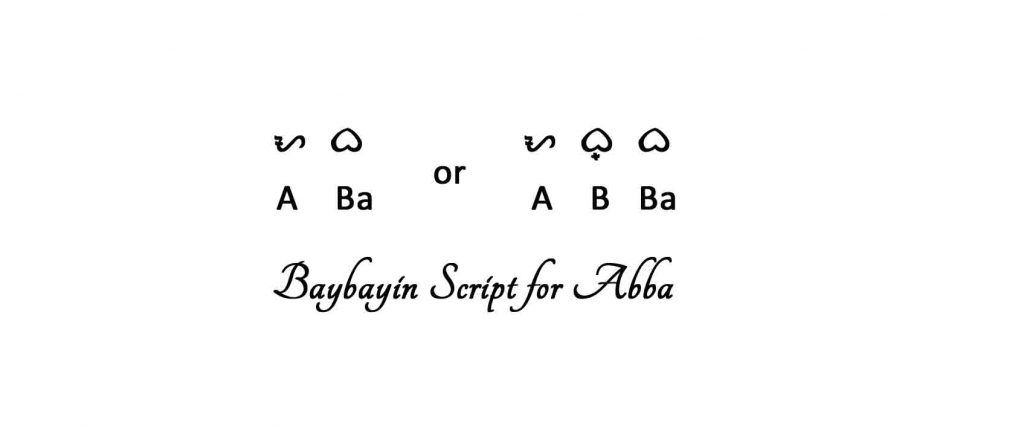
Fourthly, God Himself must have uttered the same first letters as He finished creating each perfect and magnificent part of this world: Aaah, the light is good! And when He separated the waters to form the land, what else did He say but, Aaah, the land is good! And so on. Moreover, what would He have said when He breathed life into Adam? Aaah! What else? And what name would He have given to Adam and Eve by which they could call Him other than ABBA? For ABBA in Baybayin can also be written as an obvious pictograph or word-picture of water waves and a pair of matching seashells (formed like two hearts made one in marriage in Eden), for the land or soil (Adamah) did indeed arise from the waters and the sea creatures came before man and women were created. Could they have used shells later to drink the water from the river of Pishon and donned pearls from those seashells to adorn themselves?
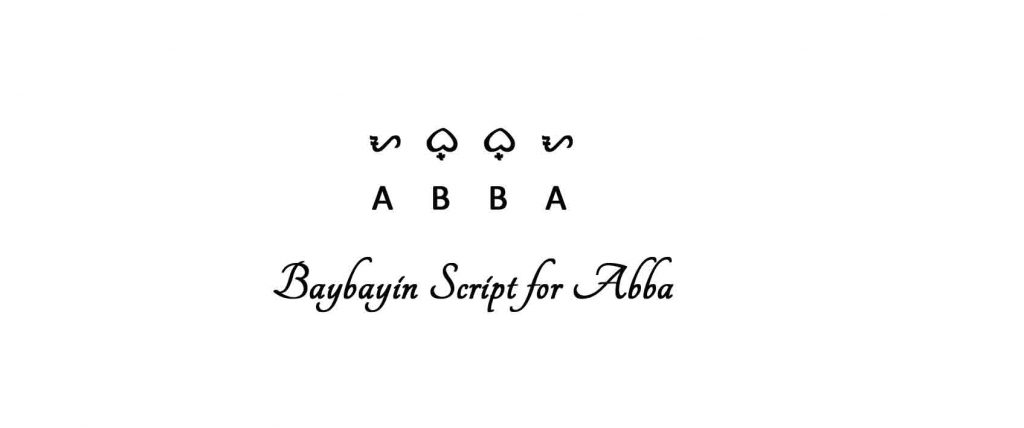
Lastly, the ancient dwellers of this Kapuluan indeed called their God ABA or ABBA, as Pigafetta recorded in his travel chronicles. (He even noted that the male natives were circumcised!) How did they know His name was ABBA? Because they were descendants of Noah! And it is where the 10 tribes would seek refuge and rest after the nation Israel was dispersed. More proofs of Christ Himself prophesying the rising of Ophir to judge the present wicked generation are given at this link.
For now, we present the whole alphabet of Baybayin to render incontrovertible proof that God had set His Word and His plan itself for Ophir and for the world for return in the final years. Here it is:
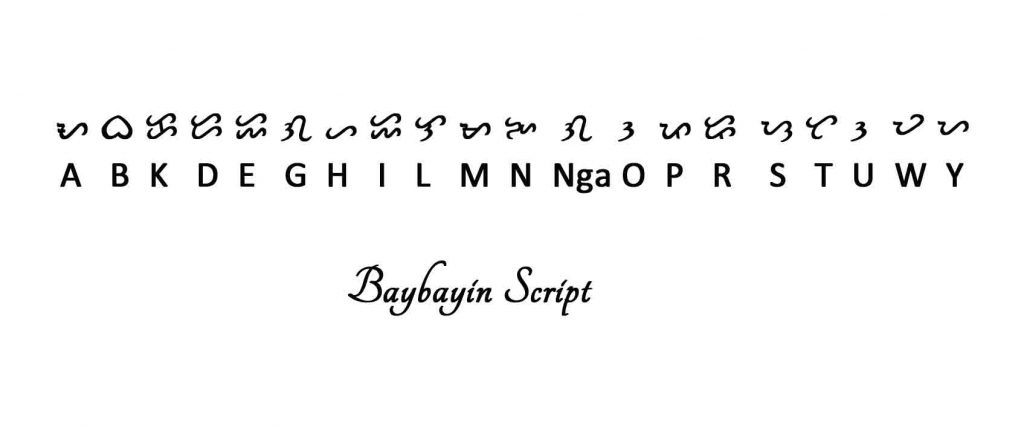
Although each letter has its own story to tell, we will forgo with that and show instead the whole picture that Baybayin can tell us in one clear, graphic, historic and spellbinding prophetic-picture we have missed for so long. Why? Perhaps, because it was erased or hidden from our ancestors’ collective memory and replaced by a whole-new, foreign way of writing and thinking. But why? What else but to put the foreigners’ agenda above that of God; for they were never true ministers or protectors of God’s Truth and Gospel. This we have proven beyond doubt in the first 2 articles. To remain blind to all the evidences only means one thing: complete deception by the dark powers that have served as masters over this Kapuluan. Only through the light of the Spirit can such blindness be finally removed. (2 Cor. 3:16)
Baybayin is a monosyllabic alphabet in that each consonant can be pronounced with a vowel (a, e, i, o or u). However, each letter is basically followed by the vowel a (pronounced ah).
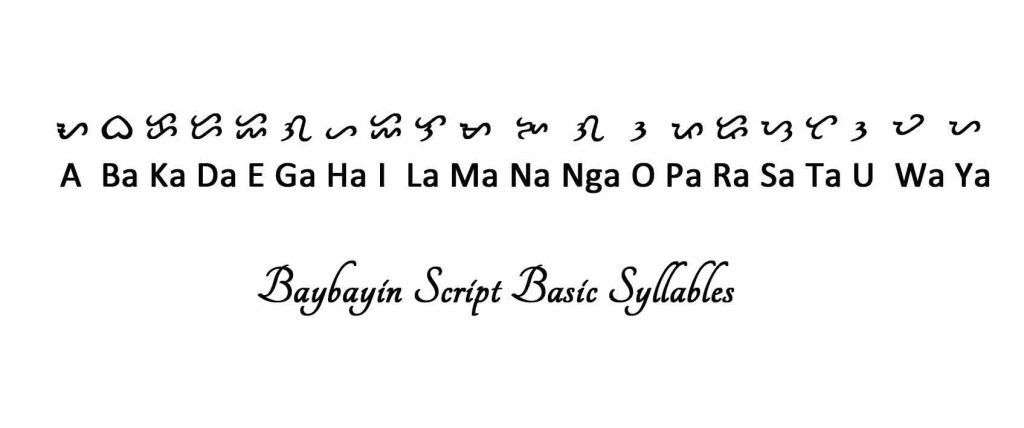
When written with a small line or wave above, the letter is pronounced with an e or i vowel. And so, basi (sugar-cane wine) is written as shown:

When written with a small line or wave below, the letter is pronounced with an o or u vowel. And so, pulô is written as shown:
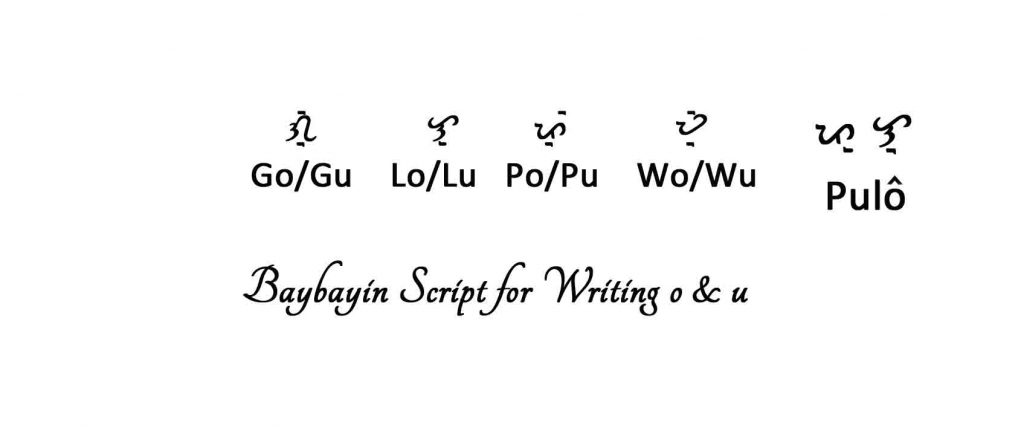
To write a consonant without a vowel after it, a small cross is written underneath it, as shown below. Therefore, Kapuluan will be written as:

For many centuries and with some slight differences, almost every child has learned to recite and read the Baybayin in this general form throughout Kupuluan, especially those who reside in Southern Luzon. It should be pointed out that D and R can be used interchangeably or, as in some dialects, R is traditionally not used, along with H, W and Y. However, since the early 20th-century, schools have taught the one general form in all primary schools in the country. In short, the senior citizens today who grew up after World War II still have it buried deep in their consciousness, their soul and their spirit. They can recite it automatically and even sing it as a popular song. Unfortunately, they sing it as a mere alphabet and not as a sentence with a deep, true meaning. We wish to correct that now.
Yes, we can lay down the whole Baybayin as one whole sentence with a precise and clear meaning from ancient times and leading into the future. Unbelievable? Here it is:
ABA kadaega i halamanang o para sa tau waya.
Slightly rearranged, the formed sentence simply means: Father God overcome(s) or subdue(s) this garden for human freedom! How uncanny is that? ABA or ABBA becomes the addressee (if a comma is put after it) or, without a comma, the subject or actor in the sentence, Who allows these luscious emerald islands to light up the freedom of humans. (Kadaega is a Visayan word whose root, daeg, daig or daug, means win or overcome. Kadaega, therefore, connotes an active or direct acquisition of victory over one’s enemies or over a territory. Waya, on the other hand, is a common dialect word which connotes being free, as in the Ilocano nawaya for free, loose or spacious. In Visayan, it is repeated as waya-waya to mean freedom.)
Now, some would say the letter i and o are out of place and have no meaning at all. Likewise, para is of Spanish origin, meaning for. But we can always say that Baybayin speaks to the present islanders according to their long historical and colonial experiences, as individuals and as a people. It now contains their Kapuluan’s history and destiny in a form that is almost anthemic and iconic. Hence, it speaks a valuable message to them, consciously or unconsciously.
So, if we rearrange the letters slightly to form another sentence with a similar meaning, we get:
ABA, kadaega halamanang Paraiso tau waya.
The garden is now identified as Paradise itself! And it is the very Garden where our first parents lived in, as we said. It is also the Paradise that we all hope to reach and where we will find total freedom (waya-waya) from this fallen world. Paraiso can also be revised as para isa, which means “to become one free people” (para isa tau waya).
A final version is presented below:
ABA, kadaega halamanang Opir sa tau waya.
This time, the garden is equated with Ophir (Opir in local form, as there is no ph or f in Baybayin.) It rounds up our conclusion that, indeed, the descendants of Noah did return to the ancient site of our first parents’ birth in the Garden of Eden, later to be known as Havilah, and where the gold of that land is good. (Gen. 2:11-12) It is the place where the lost tribes settled back in and finally found freedom. Although that freedom was taken away about 500 years ago through a series of conquering nations, God promised to give it back in the last days. Baybayin brilliantly spells that golden promise. Amen!
Although the above statements may all look contrived, their value and validity are undeniably rooted in the continuing history, multi-diverse cultural character, recorded narratives, ancient and modern beliefs and undying aspirations of the people as a whole. Most importantly, they serve as the anthropological depository of God’s revelation and His legacy to His people He will reveal and rescue in the end-times. Those who do not believe it or strive to work against it must answer eventually to Him.
And so, we see in Baybayin a hidden message, a prayer and a prophecy that express and will determine the destiny of this Kapuluan. For island-dwellers to claim this legacy and promise, they need only to see the series of events and narratives we have presented in order to be worthy of that promised blessing and reward from God. The only way God can fulfill His promise to reclaim this land for His own is when the people themselves decide they want to possess it for themselves. What can the enemies of God do against Him and His people Whom He has called to prepare for His triumphant return and to assemble His lost tribes from all over the face of the globe?
But before God will indeed gather His children once more, He has allowed the wicked rulers of this Earth to trod upon this Kapuluan with their bloodstained boots, thrash it with their murderous swords, conquer and rule over it for five hundred years. 1521 to 2021 will mark the time period which people will either recognize this proven-and-established landmark in the darkest chapters of human history or they will continue to neglect the truth and reject the declaration of the real narrative that has been hidden and suppressed for the same period of time: 500 hundred years!
But what happened in 1521 was merely the midpoint of the period when about 500 years previously, in 1054, the religious leaders who had fully established their spurious claim on the seat of Christ as supreme ruler and father, in-fact and in-name. In that year, the schism between the formerly united Eastern Greek and Western Roman wings of the Organized Church became final. Whereas previously the apostasy that created a world-based religion right after the apostles had died had split into two factions that formerly dominated the world, today, one part has been dominated by the Roman wing which had slowly gained political power and, as we have seen, practically owned the world by the 16th century.
In short, what Noah had divided according to the will of God as his rightful inheritance for saving the world and which Christ sought to redeem by His blood and promised upon His return to inherit from the Father in the end as part of His glorious Kingdom, has now been wrested away by false teachers and greedy rulers who have stained the whole world by the blood of millions of innocent people. We have seen how these people have divided the world according to a plan entirely opposed to the plans of God and in a manner so abominable to Christ’s teachings. Our national heroes have amply proven this sordid fact over-and-over again but to no avail, for their enemies and the enemies of God have remained in power till now, claiming his seat as false Father and King. So much the better for the coming True King to show how great and heavy the burdens they have placed upon the innocent children of God when He will exact His final revenge upon His enemies and vindicate His children.
Who else can claim the right and the privilege to summon God’s people and to welcome their Savior than those who have themselves been dispersed upon the Earth to await His return? What other nation has the historical experiences and the corresponding prophetic proofs and signs that point to those right and privilege than this Kapuluan – the Land of Adam and Eve, of Noah, of Noah’s descendants, of Ophir’s gold and of the Lost Tribes of Israel? The descendants of Judah who lived in Israel had generally rejected the Gospel. The present dwellers of that land are, in truth, not real descendants but a fake replacement from the Persians who later ruled the land and continue to rule today. (See this link.)
Our faith is being tested more than ever before. With this historic and prophetic word we present, are we not obliged to simply believe and pray that we can be worthy to accept it and lead our lives fully in accordance to the Original or Organic Faith delivered to the Apostles of old? There is no other way.
Finally, to end this discussion, let us look at a cultural gem that has also escaped the appreciation of many of our historians, educators and artists and round up our picture of Kapuluan being within the scope of Heaven’s plans, in the past and in the future.
In a conference paper entitled Toward a Concept of Pulô: A Metonym, Christian Benitez presented an excellent exposition of the the meanings, significances and nuances of the word “pulô“. He quotes a popular pre-colonial Tagalog “oyayi” (lullaby) that contains a historical and prophetic message. It is entitled “Ili Ili Tulog Anay“* (Lullabye, Go to Sleep) in the Ilonggo dialect and tradition with a slightly different lyric.
Meme na, bunso ko (Sleep, my youngest one)
Ang tatay mo’y wala rito (Your father is not here)
Nagpunta sa ibayo (He went to the other side)
Bumili ng puto (To buy rice cake)
Ipapakain sa iyo (To feed you)
Matulog ka na bunso (Sleep, youngest one)
Ama mo’y malayo (Your father is far away)
Hindi ka masundo (He cannot fetch you)
At may buwaya sa pulô (For a crocodile is in the island)**
Notice how the loving mother puts the child to sleep with the thought that the father is far away and is on the other side. This could picture the Father ABBA being in Heaven, as represented by the father who could not be with the child and mother. She farther comforts the child with the thought of the father bringing them rice cake. Another way of saying ABBA is coming with the Manna from Heaven. Surprisingly, the mother gives the distressing thought that the father cannot yet come to save them from danger because of the presence of a monstrous crocodile on the island. For the crocodile lives both on land and in waterways, allowing it to thrive and lurk in tropical islands and pose great danger to dwellers. Like rouge pirates who ply the seas in search of treasures and adventure, crocodiles have victimized natives and wreaked havoc in many peaceful villages.
It does not take a prophet to see that this is a historical and a prophetic message preserved in the traditional narratives of the island-dwellers of the coming of the foreign marauders from the West. And so, the mother keeps on singing the lullaby to assure the child that the father is surely coming and will deal with the monster in due time and in his predetermined way. Why should not ABBA come and finally save Kapuluan from its poverty and distress when the time comes?
Are we also singing sweetly to our Kalupuan in an endless plea and with a firm hope that ABBA will finally reclaim (kadaega) His Halamanang Paraiso (Garden of Paradise) and set free His people (Tau Waya)?
(Note: Map of Kapuluan above courtesy of www.google.com)
*”Ili Ili Tulog Anay” video from YouTube:
**Watch a video of the whole song in Tagalog with an English translation in this link and see how the lullaby farther reflects the centuries-long colonial travails of Kapuluan: